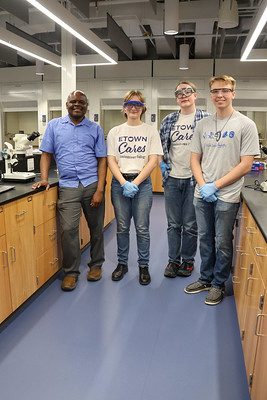Elizabethtown College students Neil Divins ’25, Andy Hoch ’25, and Samantha Small ’26 are spending their summer on campus researching the Belousov-Zhabotinsky (BZ) reaction system, an oscillatory chemical system, by testing and characterizing wave pattern formations under varying environmental conditions, such as chemical composition and temperature.
The trio is working alongside Visiting Assistant Professor of Chemistry Dr. Desmond Yengi to build a BZ reaction “recipe book” for wave pattern formations and quantifying the results by measuring wavelengths and velocities to aid future research as part of the Summer Creative Arts and Research Program (SCARP).
Title of Research
Effects of Environmental Factors on the Pattern Formation in BZ Chemical Reaction Systems
Student Researchers
Andy Hoch ’25 (Chemistry major)
Neil Divins ’25 (Chemistry major)
Samantha Small ’26 (Biochemistry and Molecular Biology major)
Faculty Mentor
Desmond Yengi, Visiting Assistant Professor of Chemistry
Hoch: Our research is based on the study of how the auto-catalytic BZ reaction operates in different conditions. My research partners and I are currently observing the reaction to find a baseline that produces good and measurable results that we can then measure the waves. The waves are the oscillating oxidation and reduction reactions occurring in the solution that produce a visible wave that can be measured. Our end goal is to compare a baseline reaction to the same reaction but with modifications to the amount of Bromide solution to see how it affects the reaction and its wave patterns.
Divins: Essentially, we’re analyzing the BZ reaction wherein a mixture of chemicals goes through a series of looping reactions. This can be visually seen as the reaction continually goes from orange to blue and back again. When this reaction is placed in a petri dish, the color change propagates throughout the reaction via waves. We want to analyze how changing parts of this reaction, such as the amount of any given substance used to make it will alter the way these waves form and propagate. Additionally, we want to then use these waves and how they change in response to a change in their environment–as a model to analyze certain biological processes and phenomena.
Small: This research aims to characterize the effect of environmental factors, including chemical composition and temperature, on wave pattern formation in the BZ reaction system. This reaction exhibits oscillation patterns, which could be used as a controlled system to study similar complex biological systems. Specifically, there have been potential connections between dynamical behaviors in the BZ reaction and neuronal signaling and amoeba movement. By characterizing the effect of environmental conditions on the BZ reaction, we can learn how to produce specific responses, which will allow the ability to understand and manipulate biological systems in future studies.
Why did you choose this topic?
Hoch: I am very interested in physical chemistry because I love the fusion between physics, mathematics, and chemistry. This research is not only exciting and beautiful to observe but can also be applied to real-world situations as the oscillation can be compared to factors in nature like a heartbeat or how neurons fire, and might later be used to create new ways to treat people with issues like irregular heartbeats.”
Divins: I wanted to work on this topic as I found the reaction incredibly fascinating and full of potential for future research. My research partners and I have already had an idea or two that we’d like to explore for research during the upcoming fall semester.
Small: I chose this topic because it excited me. When I sat in Dr. Yengi’s office to first talk about his research, I learned that there is so much more to this reaction than pretty waves and color changes. There is such a wide variety of applications, from neurons to fireflies to amoeba, that I immediately knew the importance of this work and decided I wanted to be a part of it.
What was the most interesting aspect of this research?
Hoch: The most interesting part of this research is how sensitive the reaction is, small changes can affect the whole reaction leading to a multitude of different outcomes.
Divins: The numerous ways in which this reaction can give you entirely different results due to factors that might not seem like they’re altering the final product.
Small: The most interesting aspect is figuring out what the reaction is doing when it responds to a change unexpectedly. The system is complex, so we have many factors to analyze when a different wave pattern or velocity appears.
Talk about working with your mentor. How have they helped you throughout this experience?
Hoch: Our mentor has definitely pushed me to try to find different routes of thinking to solve problems, like getting the reaction to operate in specific ways. He has encouraged me to try new things and to not be afraid of failing because every mistake opens up new avenues for success.
Divins: Our mentor has been nothing but helpful. He’s provided invaluable insight into the things we’ve done so far, and it really feels like we’re working with him to push forward and make considerable progress with our research.
Small: Dr. Yengi has provided us with a lot of freedom to test our ideas while giving advice when we get stuck and ask for help. The focus on our discoveries creates a very unique and exciting work environment.
Hear from the faculty mentor — Desmond Yengi
“Through SCARP, Etown broadens opportunities for students’ participation in independent research, which I believe is a cornerstone of undergraduate education,” Yengi said. “The independent research projects provide students with an invaluable experience that goes beyond traditional coursework. By working on their SCARP projects, Neil, Samantha, and Andrew will develop the fundamental skills required to conduct independent research.”


